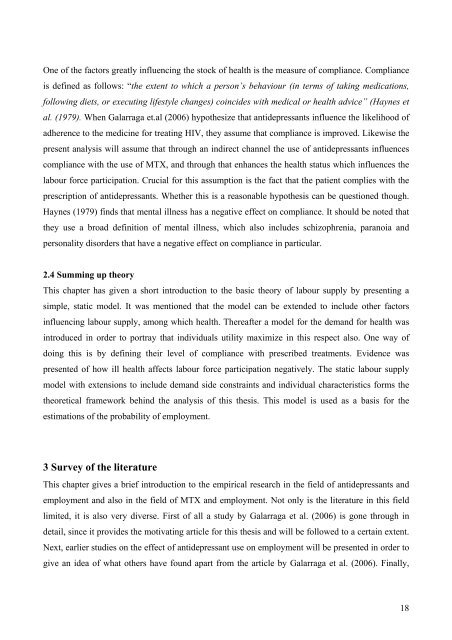An Analysis on Danish Micro Data - School of Economics and ...
An Analysis on Danish Micro Data - School of Economics and ...
An Analysis on Danish Micro Data - School of Economics and ...
Create successful ePaper yourself
Turn your PDF publications into a flip-book with our unique Google optimized e-Paper software.
One <strong>of</strong> the factors greatly influencing the stock <strong>of</strong> health is the measure <strong>of</strong> compliance. Compliance<br />
is defined as follows: “the extent to which a pers<strong>on</strong>’s behaviour (in terms <strong>of</strong> taking medicati<strong>on</strong>s,<br />
following diets, or executing lifestyle changes) coincides with medical or health advice” (Haynes et<br />
al. (1979). When Galarraga et.al (2006) hypothesize that antidepressants influence the likelihood <strong>of</strong><br />
adherence to the medicine for treating HIV, they assume that compliance is improved. Likewise the<br />
present analysis will assume that through an indirect channel the use <strong>of</strong> antidepressants influences<br />
compliance with the use <strong>of</strong> MTX, <strong>and</strong> through that enhances the health status which influences the<br />
labour force participati<strong>on</strong>. Crucial for this assumpti<strong>on</strong> is the fact that the patient complies with the<br />
prescripti<strong>on</strong> <strong>of</strong> antidepressants. Whether this is a reas<strong>on</strong>able hypothesis can be questi<strong>on</strong>ed though.<br />
Haynes (1979) finds that mental illness has a negative effect <strong>on</strong> compliance. It should be noted that<br />
they use a broad definiti<strong>on</strong> <strong>of</strong> mental illness, which also includes schizophrenia, paranoia <strong>and</strong><br />
pers<strong>on</strong>ality disorders that have a negative effect <strong>on</strong> compliance in particular.<br />
2.4 Summing up theory<br />
This chapter has given a short introducti<strong>on</strong> to the basic theory <strong>of</strong> labour supply by presenting a<br />
simple, static model. It was menti<strong>on</strong>ed that the model can be extended to include other factors<br />
influencing labour supply, am<strong>on</strong>g which health. Thereafter a model for the dem<strong>and</strong> for health was<br />
introduced in order to portray that individuals utility maximize in this respect also. One way <strong>of</strong><br />
doing this is by defining their level <strong>of</strong> compliance with prescribed treatments. Evidence was<br />
presented <strong>of</strong> how ill health affects labour force participati<strong>on</strong> negatively. The static labour supply<br />
model with extensi<strong>on</strong>s to include dem<strong>and</strong> side c<strong>on</strong>straints <strong>and</strong> individual characteristics forms the<br />
theoretical framework behind the analysis <strong>of</strong> this thesis. This model is used as a basis for the<br />
estimati<strong>on</strong>s <strong>of</strong> the probability <strong>of</strong> employment.<br />
3 Survey <strong>of</strong> the literature<br />
This chapter gives a brief introducti<strong>on</strong> to the empirical research in the field <strong>of</strong> antidepressants <strong>and</strong><br />
employment <strong>and</strong> also in the field <strong>of</strong> MTX <strong>and</strong> employment. Not <strong>on</strong>ly is the literature in this field<br />
limited, it is also very diverse. First <strong>of</strong> all a study by Galarraga et al. (2006) is g<strong>on</strong>e through in<br />
detail, since it provides the motivating article for this thesis <strong>and</strong> will be followed to a certain extent.<br />
Next, earlier studies <strong>on</strong> the effect <strong>of</strong> antidepressant use <strong>on</strong> employment will be presented in order to<br />
give an idea <strong>of</strong> what others have found apart from the article by Galarraga et al. (2006). Finally,<br />
18
















